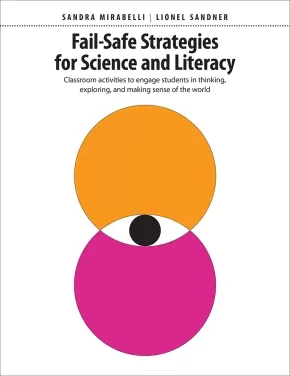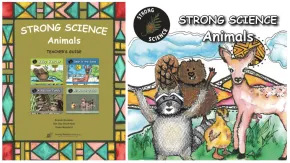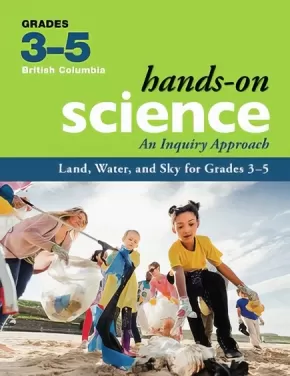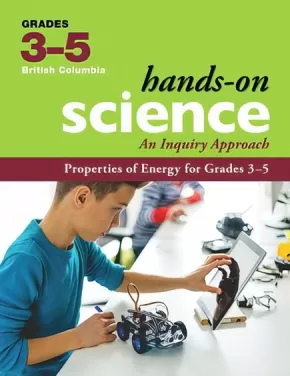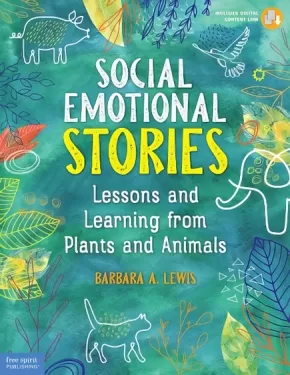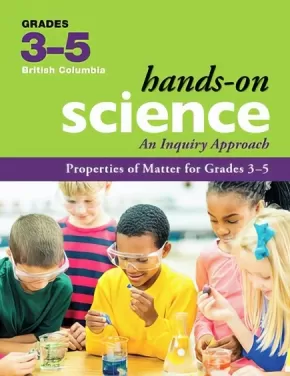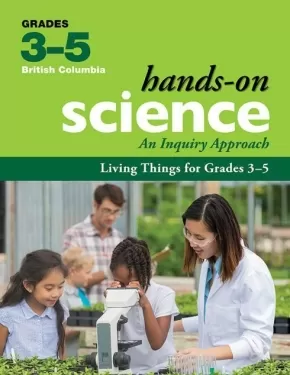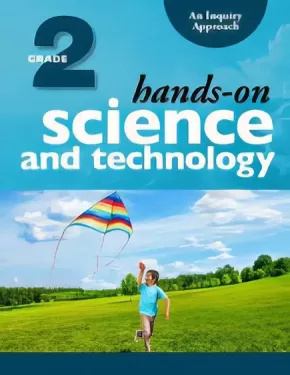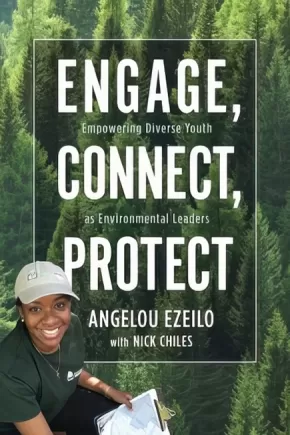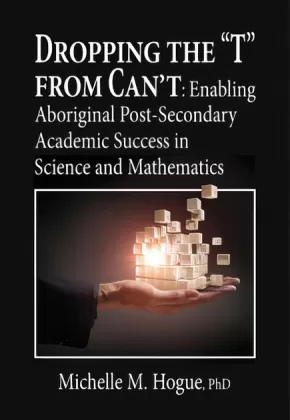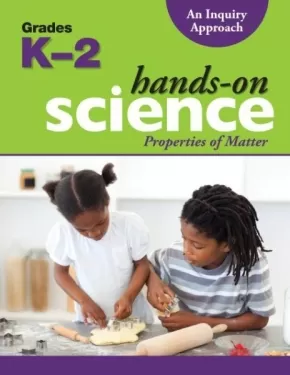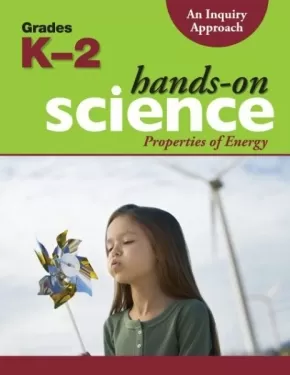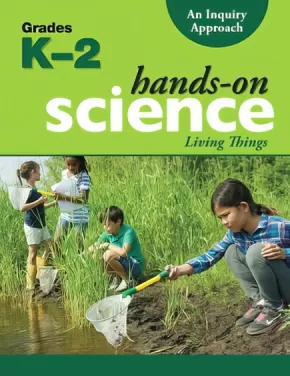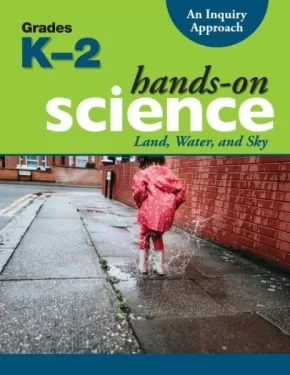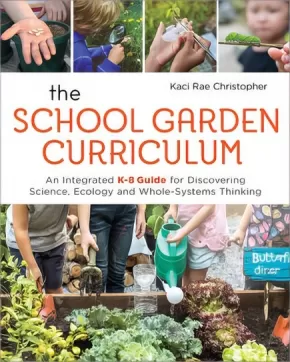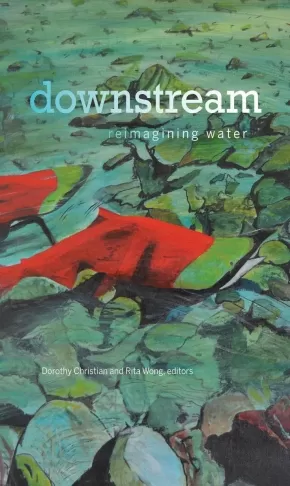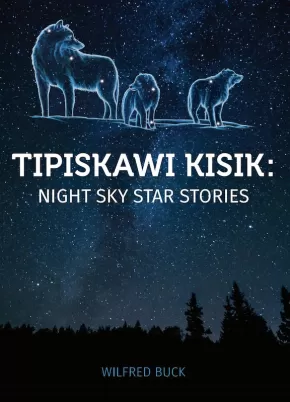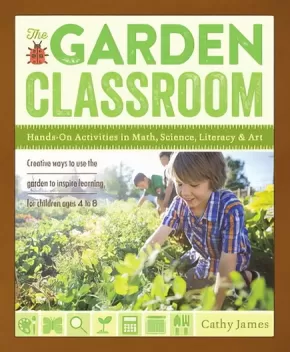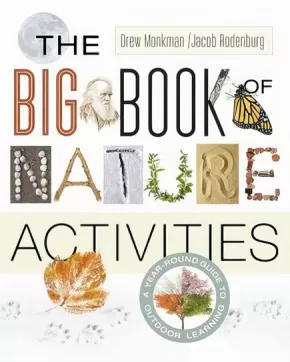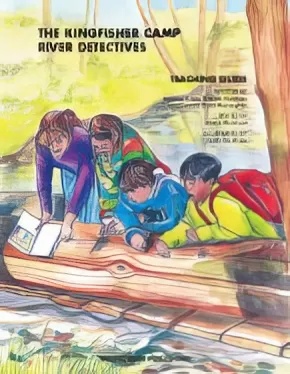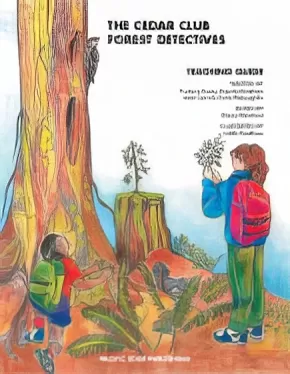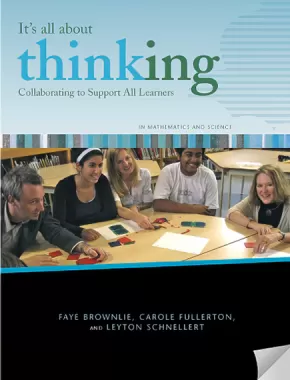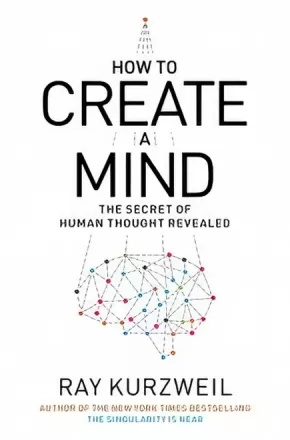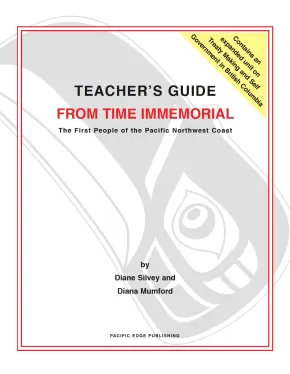
Science Resources
1
-
15
of
32 Results;
Sort By
Go To
of 3
Fail-Safe Strategies for Science & Literacy: Classroom activities to engage students in thinking, exploring, and making sense of the world
$32.95
Format:
Paperback
ISBN / Barcode: 9781551383644
Synopsis:
Synopsis:
Effective teaching can be found where science and literacy overlap. This book helps teachers streamline busy schedules by focusing on cognitive skills shared by science and language arts. Designed to help build teacher confidence, it offers the background and insights teachers need to support students as they make sense of science content through language arts study. This unique approach pairs thinking routines from literacy—Observe and Wonder; Predict and Infer; Sort and Categorize; Analyze and Interpret; and Conclude and Apply—with hands-on science activities. The engaging strategies offer a fail-safe way for students to build knowledge and skills across the curriculum.
Additional Information
160 pages | 8.38" x 10.38"
Strong Science - Animals Teacher's Guide
 $30.00
$30.00

Artists:
Format:
Coil Bound
Text Content Territories:
Indigenous Canadian; First Nations; Sioux; Lakota; Hunkpapa;
Grade Levels: 1;
ISBN / Barcode: 9781771746274
Synopsis:
Synopsis:
This teacher’s guide supports a language-based Science unit for early primary classrooms, using the sixteen titles in Strong Nations Publishing’s Strong Science - Animals series.
The unit introduces early primary students to four easily recognizable animals that live in or near many communities in Canada: beaver, black-tailed deer, mallard duck, and raccoon. While learning about the animals, students will gain knowledge and skills mandated by Ministry of Education Science curricula in Canadian provinces and territories.
In addition, this teacher’s guide addresses other curriculum areas— Language Arts, Math, Social Studies, and Art—and provides information to help develop an appreciation for and understanding of Indigenous cultures.
This teacher-friendly, comprehensive teacher’s guide provides:
• lesson plans to introduce the books in the Strong Science - Animals series;
• lesson plans to address knowledge and skills common to Canadian Science curricula;
• activities to integrate the unit across the curriculum;
• activities to wrap up the unit;
• reproducible activity pages.
Educator Information
The Strong Science - Animals series and teacher's guide is recommended for use with grade one students, but it may also be useful in kindergarten classes.
Additional Information
170 Pages | 8.5" x 11" | Coil Bound
Teacher Resource Bundle: Strong Science - Animals
 $135.00 $150.00
$135.00 $150.00

Text Content Territories:
Indigenous Canadian; First Nations; Sioux; Lakota; Hunkpapa;
Grade Levels: Kindergarten; 1;
ISBN / Barcode: 9781771746663
Synopsis:
Synopsis:
This bundle includes one copy of each of the 16 Strong Science - Animals titles and the accompanying Strong Science: Animals - Teacher's Guide.
About the Strong Science - Animals Series
Strong Science - Animals is a language-based science series for primary students featuring animals that all Canadian students will recognize. Photographs and Indigenous artwork illustrate the series. Common learning objectives in science curricula across Canada are addressed, and suggestions for extending the learning to other curriculum areas, including Indigenous cultural awareness, language arts, math, and art, are included in the teacher’s guide. The sixteen books in this series are grouped into four levels that increase in complexity, designed to accommodate students with various reading abilities within a classroom. This feature facilitates the use of this series in literacy programs along with the Strong Readers series.
Books in this series are divided into four levels: Early Primary 1 (EP1); Early Primary 2 (EP2); Early Primary 3 (EP3); Early Primary 4 (EP4). Font size decreases as language complexity and word count increase across levels: EP1 books have approximately 40 words, EP2 books have approximately 60 words, EP3 books have approximately 80 words, and EP4 books have approximately 100 words.
Each book is 16 pages, 6.5" x 5.5", and paperback
About the Strong Science - Animals: Teacher's Guide
This teacher’s guide supports a language-based Science unit for early primary classrooms, using the sixteen titles in Strong Nations Publishing’s Strong Science - Animals series.
The unit introduces early primary students to four easily recognizable animals that live in or near many communities in Canada: beaver, black-tailed deer, mallard duck, and raccoon. While learning about the animals, students will gain knowledge and skills mandated by Ministry of Education Science curricula in Canadian provinces and territories.
In addition, this teacher’s guide addresses other curriculum areas— Language Arts, Math, Social Studies, and Art—and provides information to help develop an appreciation for and understanding of Indigenous cultures.
This teacher-friendly, comprehensive teacher’s guide provides:
• lesson plans to introduce the books in the Strong Science - Animals series;
• lesson plans to address knowledge and skills common to Canadian Science curricula;
• activities to integrate the unit across the curriculum;
• activities to wrap up the unit
The teacher's guide is 170 Pages, 8.5" x 11", and coil bound
Additional Information
Teacher Resource Bundle ISBN: 9781771746663
Cree Ways of Knowing and School Science
$23.00
Format:
Paperback
Text Content Territories:
Indigenous Canadian; First Nations; Cree (Nehiyawak); Woodland Cree; Rocky Cree; Barren Lands First Nation;
Reading Level: N/A
ISBN / Barcode: 9780981151892
Synopsis:
Synopsis:
Drawing upon a variety of academic sources as well as personal and professional experiences, Dr. Michell, a member of the Barren Lands First Nation, offers a book designed to assist educators in coming to understand the larger frameworks of Cree ontology (ways of seeing the world and one’s place in it), epistemology (ways of understanding knowledge), and methodologies (ways of teaching).
While Dr. Michell’s book is a specific example of Cree culture, from northern Saskatchewan, the message is most certainly transferable beyond the Barren Lands First Nation example, and as such, offers readers entry into thinking about how to make bridges between diverse ways of knowing that is applicable cross-culturally.
Reviews
"The book Cree Ways of Knowing and School Science provides a good personal description of Cree culture and how it can improve science teaching in the classroom for First Nations students. Drawing from his experience in Northern Saskatchewan, Dr. Michell illustrates the importance of hands-on experience for students and the need to relate what they are learning in the classroom to their culture. Most importantly, Dr. Michell promotes taking the students to the knowledge holders (the Elders) and to the natural teaching lab (the land), thus incorporating traditional knowledge in the teaching of science. Elders are an essential component in this endeavour. This book will be of interest to current and prospective teachers as well as to anyone interested in cross-cultural experiences and learning. This book provides a timely contribution to the question of how to improve educational outcomes for First Nations students, a critical issue for federal, provincial and First Nations governments." - Fidji Gendron, PhD
Educator Information
Table of Contents
Preface
1. Introduction
2. Nîhîthawâk Ithînîwak
3. Nîhîthawâk Ithînîwak and School Science: A Storied Reflection
4. Nîhîthâwatîsîwîn
5. The Concept of Indigenous Science
6. The Concept of Western Science
7. Assumptions in Western and Cree Ways of Knowing
8. Promising Practices: School Science in Cree Contexts
References
About the Author
Additional Information
88 pages | 7.00" x 10.50" | Paperback
Animals Care for Mother Earth: A Teaching Resource for Personal Development
$16.95
Artists:
Format:
Paperback
Text Content Territories:
Indigenous Canadian; First Nations; Tsimshian (Ts'msysen);
ISBN / Barcode: 9781771745970
Synopsis:
Synopsis:
Animals Care for Mother Earth comprises six contemporary, interrelated stories and supporting resources for teachers. In the first story, animals cooperate to clean up a polluted pond. In subsequent stories, they care for each other in the aftermath of the pollution problem, demonstrating strength of character and social responsibility. This book can be used in elementary schools to teach—through storytelling—the value of personal strengths and community supports while incorporating Tsimshian language and knowledge into classroom lessons. It also provides many opportunities to extend the learning to other curriculum areas, including science, math, reading, writing, social studies, and art.
Reviews
"This teaching resource uses storytelling as a way to impart knowledge and initiate discussions and activities that support social and emotional learning.” – Canadian Teacher Magazine, Spring 2023 issue
Educator Information
Recommended for use with grades 1 to 6 (elementary students).
Everything educators need is included in this single work -- contemporary Indigenous stories to read aloud and explore with students, as well as story guides, a map, plant information pages, suggestions for classroom activities, discussion questions, inquiry activities, talking together points, information to support intergenerational or peer-to-peer learning, and connections to the Core Competencies and social and emotional learning (SEL) competencies.
Find a bundle for Animals Care for Mother Earth that includes the book and learning environment resources HERE!
Additional Information
32 Pages | 8.5" x 11" | ISBN: 9781771745970 | Paperback
BC Hands-On Science: An Inquiry Approach - Land, Water, and Sky for Grades 3-5
$92.00
Format:
Coil Bound
Text Content Territories:
Indigenous Canadian;
ISBN / Barcode: 9781553798804
Synopsis:
Synopsis:
Land, Water, and Sky from Hands-On Science: An Inquiry Approach completely aligns with BC’s New Curriculum for science. Grounded in the Know-Do-Understand model, First Peoples knowledge and perspectives, and student-driven scientific inquiry, this custom-written resource:
- emphasizes Core Competencies, so students engage in deeper and lifelong learning
- develops Curricular Competencies as students explore science through hands-on activities
- fosters a deep understanding of the Big Ideas in science
Using proven Hands-On features, Land, Water, and Sky contains information and materials for both teachers and students including: Curricular Competencies correlation charts; background information on the science topics; complete, easy-to-follow lesson plans; reproducible student materials; and materials lists.
Innovative new elements have been developed specifically for the new curriculum:
- a multi-age approach
- a five-part instructional process—Engage, Explore, Expand, Embed, Enhance
- an emphasis on technology, sustainability, and personalized learning
- a fully developed assessment plan for summative, formative, and student self-assessment
- a focus on real-life Applied Design, Skills, and Technologies
- learning centres that focus on multiple intelligences and universal design for learning (UDL)
- place-based learning activities, Makerspace centres, and Loose Parts
In Land, Water, and Sky students investigate characteristics of the land, water, and sky. Core Competencies and Curricular Competencies will be addressed while students explore the following Big Ideas:
- Daily and seasonal changes affect all living things.
- Observable patterns and cycles occur in the local sky and landscape.
- Water is essential to all living things, and it cycles through the environment.
Educator Information
This book is from the Hands-On Science: An Inquiry Approach (for BC) series. The new Hands-On Science comprehensive resources completely align with the redesigned Science Curriculum for British Columbia.
Recommended for grades 3 to 5.
Indigenous Consultant: Desiree Marshall-Peer, Cree-Ojibway
Indigenous Contributor: Melanie Nelson, Stó:lo¯ and In-SHUCK-ch
Table of Contents
Introduction to Hands-On Science
About Hands-On Science
Format of Hands-On Science
The Multi-Age Approach
Inquiry and Science
The Goals of Science Education in British Columbia
Hands-On Science Principles
Cultural Connections
Indigenous Perspectives and Knowledge
References
How to Use Hands-On Science in Your Classroom
Multi-Age Teaching and Learning
Module Overview
Talking Circles
Multiple Intelligences Learning Centres
Icons
Makerspaces
References
Curricular Competencies: How to Infuse Scientific Inquiry Skills and Processes Into Lessons
Observing
Questioning
Exploring
Classifying
Measuring
Communicating, Analyzing, and Interpreting
Predicting
Inferring
Inquiry Through Investigation and Experimentation
Inquiry Through Research
Addressing Students’ Literacy Needs
Online Considerations
References
The Hands-On Science Assessment Plan
Student Self-Assessment
Formative Assessment
Summative Assessment
Indigenous Perspectives on Assessment
Connecting Assessment to Curricular Competencies
Module Assessment Summary
Important Note to Teachers
References
Assessment Reproducibles
What Are the Features of the Land, Water, and Sky?
About This Module
Curriculum Learning Framework: What We Know and Understand
Curricular Competencies Correlation Chart: What We Do
Resources for Students
Initiating Event: What Do We Observe, Think, and Wonder About the Earth?
What Can We Learn About the Earth Through Stories?
What Do We Know About the Earth?
What Is the Land Like in British Columbia?
How Does Water Affect the Land?
What Are the Effects of Wind and Ice on the Landscape?
Why Do We Have a Day/Night Cycle?
Why Do We Have a Year Cycle?
What Are the Phases of the Moon?
What Is an Eclipse?
What Do We Know About Rocks and Minerals?
How Can We Compare and Classify Rocks and Minerals?
How Are Different Types of Rock Formed?
What Are Some Uses for Rocks and Minerals?
Inquiry Project: How Can We Care for the Earth’s Resources?
Appendix: Image Banks
About the Contributors
Additional Information
200 pages | 8.50" x 11.00" | Spiral Bound
BC Hands-On Science: An Inquiry Approach: Properties of Energy for Grades 3-5
$92.00
Format:
Coil Bound
Text Content Territories:
Indigenous Canadian;
ISBN / Barcode: 9781553798781
Synopsis:
Synopsis:
Properties of Energy from Hands-On Science: An Inquiry Approach completely aligns with BC’s New Curriculum for science. Grounded in the Know-Do-Understand model, First Peoples knowledge and perspectives, and student-driven scientific inquiry, this custom-written resource:
- emphasizes Core Competencies, so students engage in deeper and lifelong learning
- develops Curricular Competencies as students explore science through hands-on activities
- fosters a deep understanding of the Big Ideas in science
Using proven Hands-On features, Properties of Energy contains information and materials for both teachers and students including: Curricular Competencies correlation charts; background information on the science topics; complete, easy-to-follow lesson plans; reproducible student materials; and materials lists.
Innovative new elements have been developed specifically for the new curriculum:
- a multi-age approach
- a five-part instructional process—Engage, Explore, Expand, Embed, Enhance
- an emphasis on technology, sustainability, and personalized learning
- a fully developed assessment plan for summative, formative, and student self-assessment
- a focus on real-life Applied Design, Skills, and Technologies
- learning centres that focus on multiple intelligences and universal design for learning (UDL)
- place-based learning activities, Makerspaces, and Loose Parts
In Properties of Energy, students investigate properties of energy. Core Competencies and Curricular Competencies will be addressed while students explore the following Big Ideas:
- The motion of objects depends on their properties.
- Light and sound can be produced and their properties can be changed.
- Forces influence the motion of an object.
Educator & Series Information
This book is from the Hands-On Science: An Inquiry Approach (for BC) series. The new Hands-On Science comprehensive resources completely align with the redesigned Science Curriculum for British Columbia.
Recommended for use with students in grades 3 to 5.
Additional Information
200 pages | 8.50" x 11.00"
Social Emotional Stories: Lessons and Learnings from Plants and Animals
$54.50
Format:
Paperback
ISBN / Barcode: 9781631985140
Synopsis:
Synopsis:
This resource for educators makes social emotional learning fun and engaging with 24 ready-to-use lessons about phenomenal plants and astonishing animals.
Storytelling is a learning device used by humans for centuries, and for good reason: storytelling is one of the best ways to increase critical thinking skills and social emotional learning (SEL). Social Emotional Stories combines storytelling with thought-provoking lessons and activities to help elementary students improve their self-esteem, increase their engagement with school, and give them a sense of empowerment.
The book contains 24 individual lessons that include:
- An SEL objective with specific keywords like “inner strength,” “problem solving,” and “responsibility”
- An engaging story that focuses on a distinctive quality of either a plant (like the inner strength of bamboo) or an animal (like the courage of a pig)
- Multiple activities that are quick, easy, and require few supplies to help kids identify and dive deeper into the specific SEL concepts represented
Educators can use these lessons individually with students, in small groups, or with an entire class. The lessons are interdisciplinary and flexible, with only minimal prep time required, allowing educators to adapt them for their situation. Extensive digital content supports the lessons with reproducible forms and a full-color photo of each plant and animal.
Reviews
“Lewis introduces fascinating aspects of the natural world—its constructive and destructive power—to young students in a way that reaches beyond knowledge acquisition. She shows teachers how to build bridges to the inner worlds of children with analogical thinking, reflective questions, and thoughtful conversations that nourish not only their understanding but their agency. If you want to use learning as a way to develop your students’ character, intrinsic motivation, and an ethically grounded relationship with the world, this is the guide you need.”—Diane Stirling
“Barbara Lewis weaves factual information with down-to-earth, applicable activities and discussions to encourage students’ appreciation for nature, while building their power to observe and to understand people and their world as multidimensional. Throughout, Lewis is respectful of children’s capacity to discuss important issues and form their own opinions.”—Silvia Blitzer Golombek
“Another delightful book from Barbara Lewis, Social Emotional Stories is filled with fascinating depictions and insightful analogies to support character development. We recommend Barbara Lewis’s books to all the families who seek our services. Believing that children can make a difference, Lewis provides the inspiration for helping others, taking a stand against injustice, squelching rumors, and seeing beyond stereotypes. This book should be a staple in every school’s social-emotional learning curriculum.”—Linda Kreger Silverman, Ph.D., licensed psychologist, director of the Gifted Development Center
Educator Information
Recommended for grades 2 to 5.
Additional Information
176 pages | 8.50" x 11.00"
Natural Curiosity 2nd Edition: A Resource for Educators: Considering Indigenous Perspectives in Children's Environmental Inquiry
$55.00
Text Content Territories:
Indigenous Canadian;
ISBN / Barcode: 9780772726438
Synopsis:
Synopsis:
The second edition of Natural Curiosity supports a stronger basic awareness of Indigenous perspectives and their importance to environmental education. The driving motivation for a second edition was the burning need, in the wake of strong and unequivocal recommendations by the Truth and Reconciliation Commission, to situate Indigenous perspectives into the heart of Canadian educational settings and curricula, most notably in connection with environmental issues.
The Indigenous lens in this edition represents a cross-cultural encounter supporting what can become an ongoing dialogue and evolution of practice in environmental inquiry. Some important questions are raised that challenge us to think in very different ways about things as fundamental as the meaning of knowledge.
New in the Second Edition: Revision of the four branches of environmental inquiry (Lorraine Chiarotto), by Julie Comay; Indigenous lenses on each of the branches by Doug Anderson; 16 new educator stories.
Reviews
"Natural Curiosity 2nd Edition is an excellent resource for educators seeking to act as co-inquirers with their students and share the learning spirit while fostering relationship with our natural kin and relations. With a newly expanded lens on Indigenous perspectives and worldviews, this resource encourages teachers with philosophies, rationales, tools and activities to help them grow ecological and social justice citizens. A timely resource and highly recommended." -- Jean-Paul Restoule
"In Natural Curiosity 2nd Edition, Western ways of relating to nature intermingle with Indigenous ways. The book respects the integrity of both coexisting cultural perspectives. By understanding both, readers and their students will gain greater curiosity and deeper insights to make sense of the world around them or to solve problems." -Dr Glen S Aikenhead
Additional Information
284 pages | 8.40" x 10.90" | 2nd Edition
BC Hands-On Science: An Inquiry Approach: Properties of Matter for Grades 3-5
$92.00
Format:
Coil Bound
Text Content Territories:
Indigenous Canadian;
ISBN / Barcode: 9781553798798
Synopsis:
Synopsis:
Properties of Matter from Hands-On Science for British Columbia completely aligns with BC’s New Curriculum for Science. Grounded in the Know-Do-Understand model, First Peoples knowledge and perspectives, and student-driven scientific inquiry, this custom-written resource:
- emphasizes Core Competencies, so students engage in deeper and lifelong learning
- develops Curricular Competencies through hands-on activities
- fosters a deep understanding of the Big Ideas in science
Using proven Hands-On features, Properties of Matter contains information and materials for both teachers and students including: Curricular Competencies correlation charts; background information on the science topics; complete, easy-to-follow lesson plans; reproducible student materials; and materials lists.
Innovative new elements have been developed specifically for the new curriculum:
- a multi-age approach
- an emphasis on technology, sustainability, and personalized learning
- a fully developed assessment plan for summative, formative, and student self-assessment
- a focus on real-life Applied Design, Skills, and Technologies
- learning centres that focus on multiple intelligences and universal design for learning (UDL)
- place-based learning activities and Makerspaces
Properties of Matter for Grades 3-5 addresses Core Competencies and Learning Standards while students
explore the following Big Ideas:
- All matter is made of particles.
- Matter has mass, takes up space, and can change phase.
- Solutions are homogeneous.
Educator Information
This book is from the Hands-On Science: An Inquiry Approach (for BC) series. The new Hands-On Science comprehensive resources completely align with the redesigned Science Curriculum for British Columbia.
Recommended for use with students in grades 3 to 5.
Additional Information
200 pages | 8.50" x 11.00"
BC Hands-On Science: An Inquiry Approach - Living Things for Grades 3-5
$92.00
Format:
Coil Bound
Text Content Territories:
Indigenous Canadian;
ISBN / Barcode: 9781553798750
Synopsis:
Synopsis:
Living Things from Hands-On Science for British Columbia completely aligns with BC’s New Curriculum for Science. Grounded in the Know-Do-Understand model, First Peoples knowledge and perspectives, and student-driven scientific inquiry, this custom-written resource:
- emphasizes Core Competencies, so students engage in deeper and lifelong learning
- develops Curricular Competencies through hands-on activities
- fosters a deep understanding of the Big Ideas in science
Using proven Hands-On features, Living Things contains information and materials for both teachers and students including: Curricular Competencies correlation charts; background information on the science topics; complete, easy-to-follow lesson plans; reproducible student materials; and materials lists.
Innovative new elements have been developed specifically for the new curriculum:
- a multi-age approach
- an emphasis on technology, sustainability, and personalized learning
- a fully developed assessment plan for summative, formative, and student self-assessment
- a focus on real-life Applied Design, Skills, and Technologies
- learning centres that focus on multiple intelligences and universal design for learning (UDL)
- place-based learning activities and Makerspaces
Living Things for Grades 3-5 addresses Core Competencies and Learning Standards while students
explore the following Big Ideas:
- Living things are diverse, can be grouped, and interact in their ecosystems.
- All living things sense and respond to their environment.
- Multicellular organisms have organ systems that enable them to survive and interact within their environment.
Educator Information
This book is from the Hands-On Science: An Inquiry Approach (for BC) series. The new Hands-On Science comprehensive resources completely align with the redesigned Science Curriculum for British Columbia.
Recommended for use with students in grades 3 to 5.
Additional Information
150 pages | 8.50" x 11.00"
Hands-On Science and Technology: An Inquiry Approach - Grade 2 (1 in stock)
$136.00
Format:
Coil Bound
Text Content Territories:
Indigenous Canadian;
Grade Levels: 2;
ISBN / Barcode: 9781553797074
Synopsis:
Synopsis:
Hands-On Science and Technology: An Inquiry Approach is filled with a year’s worth of classroom-tested activity-based lesson plans. The grade 2 book is divided into four units based on the current Ontario curriculum for science and technology:
- Growth and Changes in Animals
- Movement
- Properties of Liquids and Solids
- Air and Water in the Environment
This new edition includes many familiar great features for both teachers and students: curriculum correlation charts; background information on the science and technology topics; complete, easy-to-follow lesson plans; reproducible student materials; materials lists; and hands-on, student-centred activities.
Useful new features include:
- the components of an inquiry-based scientific and technological approach
- Indigenous knowledge and perspective embedded in lesson plans
- a four-part instructional process—activate, action, consolidate and debrief, and enhance
- an emphasis on technology, sustainability, and differentiated instruction
- a fully developed assessment plan that includes opportunities for assessment for, as, and of learning
- a focus on real-life technological problem solving
- learning centres that focus on multiple intelligences and universal design for learning (UDL)
- land-based learning activities
- a bank of science-related images
Educator& Series Information
This book is from the Hands-On Science: An Inquiry Approach (for Ontario) series.
Recommended for grade 2.
Includes some Indigenous content/perspectives from Indigenous Consultant Kevin Reed.
Additional Information
|
Engage, Connect, Protect: Empowering Diverse Youth as Environmental Leaders
$19.99
Format:
Paperback
Text Content Territories:
Indigenous American; Native American;
ISBN / Barcode: 9780865719187
Synopsis:
Synopsis:
Building environmental strength through a diversity of youth.
While concern about the state of our land, air, and water continues to grow, there is widespread belief that environmental issues are primarily of interest to wealthy white communities. Engage, Connect, Protect explodes this myth, revealing the deep and abiding interest that African American, Latino, and Native American communities – many of whom live in degraded and polluted parts of the country – have in our collective environment.
Part eye-opening critique of the cultural divide in environmentalism, part biography of a leading social entrepreneur, and part practical toolkit for engaging diverse youth, Engage, Connect, Protect covers:
- Why communities of color are largely unrecognized in the environmental movement
- Bridging the cultural divide and activate a new generation of environmental stewards
- A curriculum for engaging diverse youth and young adults through culturally appropriate methods and activities
- A resource guide for connecting mainstream America to organizations working with diverse youth within environmental projects, training, and employment.
Engage, Connect, Protect is a wake-up call for businesses, activists, educators, and policymakers to recognize the work of grassroots activists in diverse communities and create opportunities for engaging with diverse youth as the next generation of environmental stewards.
Educator Information
While this work has a US focus, it is still extremely relevant in other countries like Canada.
Additional Information
256 pages | 6.00" x 9.00"
Dropping the 'T' from CAN'T: Enabling Aboriginal Post-Secondary Academic Success in Science and Mathematics (1 in Stock, Out of Print)
$27.00
Format:
Paperback
Text Content Territories:
Indigenous Canadian;
Grade Levels: University/College;
ISBN / Barcode: 9781926476186
Synopsis:
Synopsis:
Within Dropping the “T” from CAN'T, Dr. Michelle Hogue presents and analyses interviews with eight highly successful Indigenous women and men in order to discern what enables Indigenous people to become successful in the sciences and mathematics such that they are able to pursue related professions. Importantly, Dr. Hogue presents interviews with two Indigenous individuals who started yet did not complete advanced degrees in order to find out what impediments brought their academic journeys to a premature end.
Dr. Hogue’s interview findings, paired with current and relevant literature, serves to enlighten and support the Truth and Reconciliation Commissions Calls to Action to provide culturally relevant education for Aboriginal learners. Education must be culturally and holistically relevant in order to invite, engage, and enable learners; this is true of both Aboriginal and non-Aboriginal learners. While this book specifically examines science and mathematics education, the lessons and findings will apply across disciplines.
Foreword by Dr. Laara Fitznor. Reviews by: Dr.'s Cheryl Bartlett, Fidgi Gendron, Yvonne Poitress Pratt, and Leroy Little Bear.
Reviews
"Indigenous students CAN succeed in post-secondary science and mathematics! This is the clear message in Dr. Hogue’s book. Recognizing, reshaping, and retelling insights about success within personal stories requires a skillful story worker and Dr. Hogue is superb. Using the Medicine Wheel, she conveys understandings ‘wholistically’ to provide the much-needed complement to institutional STEM pathways and programs. Hers is a book for everyone: students, educators, academics, administrators, leaders, funders, parents, youth ..." — Cheryl Bartlett
"What a refreshing book! Michelle Hogue celebrates Aboriginal women and men who journeyed through post-secondary education in science and mathematics and achieved their dreams. She examines their successes and challenges and highlights how Aboriginal science and Western science can come together to reach inclusive learning and knowing. These stories will inspire not only Aboriginal people but everybody to not give up and work hard to reach their goals." — Fidji Gendron
"As educators continue to ask how all subject areas can be Indigenized, Hogue steps into contested teaching and learning territory with the same fearless attitude she takes in teaching math and science from an Indigenous perspective. This fascinating book contains insights and stories from Indigenous scientists providing irrefutable evidence there is no anomaly between being Indigenous and being a scientist." — Yvonne Poitras Pratt
"Michelle is an extremely good writer. I can tell she put a tremendous amount of research into the book. I very much like her layout of the Medicine Wheel into: Spring, Summer, Fall, and Winter. Doing so clearly brings out the barriers to science education for Indigenous students. Overall, the book makes the point that the ’T’ can be dropped from CAN’T providing we know the culture of Indigenous students and the struggles they have to go through to fulfill their personal goals of becoming scientists." — Leroy Little Bear
Educator Information
Table of Contents
Acknowledgements and Dedication
A Note on Terms
Table of Contents
Foreword, By: Laara Fitznor, EdD
Preface: Tan’si, Hello
SPRING
Prologue
Introduction: The Environment
Puzzlements and Questions
SUMMER
Women’s Journey
Men’s Journey
Re-framing the Journey
The Talking Circle
FALL
Understanding the Space Between
Navigating the Space Between
WINTER
Coming to Understand
Philosophically Navigating
Reframing: Coming Full Circle
A NEW CYCLE
Bridging Cultures, Two-Eyed Seeing & the 21st Century
Final Reflections
The Equation for Success
Appendix
References
Index
About the Author
Additional Information
199 pages | 6.00" x 9.00"
BC Hands-On Science: An Inquiry Approach - Properties of Matter for Grades K-2
$92.00
Format:
Coil Bound
Text Content Territories:
Indigenous Canadian;
ISBN / Barcode: 9781553797999
Synopsis:
Synopsis:
Properties of Matter from Hands-On Science: An Inquiry Approach completely aligns with the redesigned Science Curriculum for British Columbia. Grounded in the Know-Do-Understand model, First Peoples’ knowledge and perspectives, and student-driven scientific inquiry, this custom-written resource:
- emphasizes Core Competencies, so students engage in deeper and lifelong learning
- develops Curricular Competencies as students explore science through hands-on activities
- fosters a deep understanding of the Big Ideas in science
Using proven Hands-On features, Properties of Matter contains information and materials for both teachers and students including: Curricular Competencies correlation charts; background information on the science topics; complete, easy-to-follow lesson plans; reproducible student materials; and materials lists.
Innovative new elements have been developed specifically for the new curriculum:
- a multi-age approach
- a five-part instructional process—Engage, Explore, Expand, Embed, Enhance
- an emphasis on technology, sustainability, and personalized learning
- a fully developed assessment plan for summative, formative, and student self-assessment
- a focus on real-life Applied Design, Skills, and Technologies
- learning centres that focus on multiple intelligences and universal design for learning (UDL)
- place-based learning activities, Makerspace centres, and Loose Parts
In Properties of Matter students investigate matter. Core Competencies and Curricular Competencies will be addressed while students explore the following Big Ideas:
- Humans interact with matter every day through familiar materials.
- Materials can be changed through physical and chemical processes.
- Matter is useful because of its properties.
Educator Information
This book is from the Hands-On Science: An Inquiry Approach (for BC) series. The new Hands-On Science comprehensive resources completely align with the redesigned Science Curriculum for British Columbia.
Recommended for use with children ages 4-8.
Additional Information
150 pages | 8.5" x 11"
BC Hands-On Science: An Inquiry Approach - Properties of Energy for Grades K-2
$92.00
Format:
Coil Bound
Text Content Territories:
Indigenous Canadian;
ISBN / Barcode: 9781553797982
Synopsis:
Synopsis:
Properties of Energy from Hands-On Science: An Inquiry Approach completely aligns with the redesigned Science Curriculum for British Columbia. Grounded in the Know-Do-Understand model, First Peoples’ knowledge and perspectives, and student-driven scientific inquiry, this custom-written resource:
- emphasizes Core Competencies, so students engage in deeper and lifelong learning
- develops Curricular Competencies as students explore science through hands-on activities
- fosters a deep understanding of the Big Ideas in science
Using proven Hands-On features, Properties of Energy contains information and materials for both teachers and students including: Curricular Competencies correlation charts; background information on the science topics; complete, easy-to-follow lesson plans; reproducible student materials; and materials lists.
Innovative new elements have been developed specifically for the new curriculum:
- a multi-age approach
- a five-part instructional process—Engage, Explore, Expand, Embed, Enhance
- an emphasis on technology, sustainability, and personalized learning
- a fully developed assessment plan for summative, formative, and student self-assessment
- a focus on real-life Applied Design, Skills, and Technologies
- learning centres that focus on multiple intelligences and universal design for learning (UDL)
- place-based learning activities, Makerspace centres, and Loose Parts
In Properties of Energy students investigate properties of energy. Core Competencies and Curricular Competencies will be addressed while students explore the following Big Ideas:
- The motion of objects depends on their properties.
- Light and sound can be produced and their properties can be changed.
- Forces influence the motion of an object.
Educator Information
This book is from the Hands-On Science: An Inquiry Approach (for BC) series. The new Hands-On Science comprehensive resources completely align with the redesigned Science Curriculum for British Columbia.
Recommended for use with children ages 4-8.
Additional Information
181 pages | 8.5 " x 11"
BC Hands-On Science: An Inquiry Approach - Living Things for Grades K-2
$92.00
Format:
Coil Bound
Text Content Territories:
Indigenous Canadian;
ISBN / Barcode: 9781553797555
Synopsis:
Synopsis:
Living Things from Hands-On Science: An Inquiry Approach completely aligns with the redesigned Science Curriculum for British Columbia. Grounded in the Know-Do-Understand model, First Peoples’ knowledge and perspectives, and student-driven scientific inquiry, this custom-written resource:
- emphasizes Core Competencies, so students engage in deeper and lifelong learning
- develops Curricular Competencies as students explore science through hands-on activities
- fosters a deep understanding of the Big Ideas in science
Using proven Hands-On features, Living Things contains information and materials for both teachers and students including: Curricular Competencies correlation charts; background information on the science topics; complete, easy-to-follow lesson plans; reproducible student materials; and materials lists.
Innovative new elements have been developed specifically for the new curriculum:
- a multi-age approach
- a five-part instructional process—Engage, Explore, Expand, Embed, Enhance
- an emphasis on technology, sustainability, and personalized learning
- a fully developed assessment plan for summative, formative, and student self-assessment
- a focus on real-life Applied Design, Skills, and Technologies
- learning centres that focus on multiple intelligences and universal design for learning (UDL)
- place-based learning activities, Makerspace centres, and Loose Parts
In Living Things students investigate plants and animals. Core Competencies and Curricular Competencies will be addressed while students explore the following Big Ideas:
- Plants and animals have observable features.
- Living things have features and behaviours that help them survive in their environment.
- Living things have life cycles adapted to their environment.
Educator Information
This book is from the Hands-On Science: An Inquiry Approach (for BC) series. The new Hands-On Science comprehensive resources completely align with the redesigned Science Curriculum for British Columbia.
Recommended for use with children ages 4-8.
Additional Information
150 pages | 8.5 " x 11"
BC Hands-On Science: An Inquiry Approach - Land, Water, and Sky for Grades K-2
$92.00
Format:
Coil Bound
Text Content Territories:
Indigenous Canadian;
ISBN / Barcode: 9781553797975
Synopsis:
Synopsis:
Land, Water, and Sky from Hands-On Science: An Inquiry Approach completely aligns with the redesigned Science Curriculum for British Columbia. Grounded in the Know-Do-Understand model, First Peoples’ knowledge and perspectives, and student-driven scientific inquiry, this custom-written resource:
- emphasizes Core Competencies, so students engage in deeper and lifelong learning
- develops Curricular Competencies as students explore science through hands-on activities
- fosters a deep understanding of the Big Ideas in science
Using proven Hands-On features, Land, Water, and Sky contains information and materials for both teachers and students including: Curricular Competencies correlation charts; background information on the science topics; complete, easy-to-follow lesson plans; reproducible student materials; and materials lists.
Innovative new elements have been developed specifically for the new curriculum:
- a multi-age approach
- a five-part instructional process—Engage, Explore, Expand, Embed, Enhance
- an emphasis on technology, sustainability, and personalized learning
- a fully developed assessment plan for summative, formative, and student self-assessment
- a focus on real-life Applied Design, Skills, and Technologies
- learning centres that focus on multiple intelligences and universal design for learning (UDL)
- place-based learning activities, Makerspace centres, and Loose Parts
In Land, Water, and Sky students investigate characteristics of the land, water, and sky. Core Competencies and Curricular Competencies will be addressed while students explore the following Big Ideas:
- Daily and seasonal changes affect all living things.
- Observable patterns and cycles occur in the local sky and landscape.
- Water is essential to all living things, and it cycles through the environment.
Educator Information
This book is from the Hands-On Science: An Inquiry Approach (for BC) series. The new Hands-On Science comprehensive resources completely align with the redesigned Science Curriculum for British Columbia.
Recommended for use with children ages 4-8.
Additional Information
150 pages | 8.5 " x 11"
The School Garden Curriculum: An Integrated K-8 Guide for Discovering Science, Ecology, and Whole-Systems Thinking
$49.99
Format:
Paperback
ISBN / Barcode: 9780865719057
Synopsis:
Synopsis:
Sow the seeds of science and wonder and inspire the next generation of Earth stewards.
The world needs young people to grow into strong, scientifically literate environmental stewards. Learning gardens are great places to build this knowledge, yet until now there has been a lack of a multi-grade curriculum for school-wide teaching aimed at fostering a connection with the Earth.
The School Garden Curriculum offers a unique and comprehensive framework, enabling students to grow their knowledge throughout the school year and build on it from kindergarten to eighth grade. From seasonal garden activities to inquiry projects and science-skill building, children will develop organic gardening solutions, a positive land ethic, systems thinking, and instincts for ecological stewardship.
The book offers:
- A complete K-8 school-wide framework
- Over 200 engaging, weekly lesson plans – ready to share
- Place-based activities, immersive learning, and hands-on activities
- Integration of science, critical thinking, permaculture, and life skills
- Links to Next Generation Science Standards
- Further resources and information sources.
A model and guide for all educators, The School Garden Curriculum is the complete package for any school wishing to use ecosystem perspectives, science, and permaculture to connect children to positive land ethics, personal responsibility, and wonder, while building vital lifelong skills.
Additional Information
320 pages | 8.10" x 10.00"
downstream: reimagining water
$36.99
Format:
Paperback
Text Content Territories:
Indigenous Canadian;
ISBN / Barcode: 9781771122139
Synopsis:
Synopsis:
downstream: reimagining water brings together artists, writers, scientists, scholars, environmentalists, and activists who understand that our shared human need for clean water is crucial to building peace and good relationships with one another and the planet. This book explores the key roles that culture, arts, and the humanities play in supporting healthy water-based ecology and provides local, global, and Indigenous perspectives on water that help to guide our societies in a time of global warming. The contributions range from practical to visionary, and each of the four sections closes with a poem to encourage personal freedom along with collective care.
This book contributes to the formation of an intergenerational, culturally inclusive, participatory water ethic. Such an ethic arises from intellectual courage, spiritual responsibilities, practical knowledge, and deep appreciation for human dependence on water for a meaningful quality of life. downstream illuminates how water teaches us interdependence with other humans and living creatures, both near and far.
Reviews
"Downstream stakes out a bold and creative claim to collaborative and cross-cultural eco-spiritual-neo-traditional knowing and, with it, new approaches to policy and action. A timely read that lends depth and resonance to some of the material and voices [in other books on the subject]." — Heather Menzies, Literary Review of Canada, June 2017
"This rich collection brings together the work of artists, writers, scientists, scholars, environmentalists, and activists, all focusing on the looming global water crisis. ... Writing styles vary from piece to piece throughout the book—poetic, personal, journalistic, and academic—but the shifts between each are well worth navigating for any reader interested in human futures on Earth."— Publishers Weekly, August 2017
"This collection of works successfully expands our knowledge of and experience with water by merging natural science, social science, arts, and humanities approaches to water. It offers new, innovative, and engaging ways to think about and experience water, especially as it relates to life and vitality."— Sara Beth Keough, American Review of Canadian Studies, November -0001
Educator Information
This collection of essays is useful for these course/subject areas or topics: Language Arts & Disciplines; Creative Writing; Indigenous Studies; Poetry; Environmental Studies; Environmental Humanities.
Table of Contents
Introduction: Re-storying Waters, Re-storying Relations / Rita Wong and Dorothy Christian
Part I: Contexts for Knowing and Unknowing Water
1. Planetary Distress Signals / Alanna Mitchell
2. Water / Lee Maracle
3. Interweaving Water: The Incremental Transformation of Sovereign Knowledge into Collaborative Knowledge / Michael D. Blackstock
4. Water and Knowledge / Astrida Neimanis
5. Excerpts from “a child’s fable” / Baco Ohama
Part II: Water Testimonies: Witness, Worry, and Work
6. Water: The First Foundation of Life / Mona Polacca
7. From Our Homelands to the Tar Sands / Melina Laboucan Massimo
8. Keepers of the Water: Nishnaabe-kwewag Speaking for the Water / Renee Elizabeth Mzinegiizhigo-kwe Bedard
9. Water Walk Pedagogy / Violet Caibaiosai
10. A Response to Pascua Lama / Cecilia Vicuna
Part III: Shared Ethical and Embodied Practices
11. Moving with Water: Relationship and Responsibilities / Alannah Young Leon and Denise Marie Nadeau
12. Bodies of Water: Meaning in Movement / Seonagh Odhiambo Horne
13. Upstream: A Conversation with Water / Cathy Stubington
14. Ice Receding, Books Reseeding / Basia Irland
15. Tsunami Chant / Wang Ping
Part IV: A Respectful Co-existence in Common: Water Perspectives
16. Listening to the Elders at the Keepers of the Water Gathering /Radha D’Souza
17. Coastal Waters in Distress from Excessive Nutrients / Paul J. Harrison
18. Bodies of Water: Asian Canadians In/Action with Water /Janey Lew
19. Permeable Toronto: A Hydro-Eutopia / Janine MacLeod
20. Saturate/Dissolve: Water for Itself, Un-Settler Responsibilities, and Radical Humility / Larissa Lai
21. Bring Me Back / Janet Rogers
Additional Information
300 pages | 6.00" x 9.00"
Tipiskawi Kisik: Night Sky Star Stories
$15.00
Format:
Paperback
Text Content Territories:
Indigenous Canadian; First Nations; Cree (Nehiyawak);
ISBN / Barcode: 9781927849460
Synopsis:
Synopsis:
Like the night sky above, Tipiskawi Kisik holds a myriad of tales rooted in an Ininew (Cree) perspective. An exploration of stars and constellations—and their associated mythologies—will greet you with age-old knowledge held by Indigenous people prior to European contact. Through Wilfred Buck’s creative, spiritual, and intelligent understanding of the stars, it will be easy to imagine yourself flying inside the Milky Way with Niska (the Goose) or chasing Mista Muskwa (the Great Bear), just like Tepakoop Pinesisuk (the Seven Birds). Above all, these stories can be passed on to the next generation, so they will know of the rich history, science practices, and culture of the Ininew people.
Additional Information
This is a collection of short stories (approximately 25 pages long) with supporting artwork/illustrations. While not aimed at young readers in terms of reading level, this book would support educators in their teaching of Indigenous astronomy to younger audiences, especially since each short story would work well as a read aloud and includes useful illustrations/diagrams of the night sky.
The Garden Classroom: Hands-On Activities in Math, Science, Literacy, and Art
$28.95
Format:
Paperback
ISBN / Barcode: 9781611801644
Synopsis:
Synopsis:
Creative ways to use the garden to inspire learning, for kids ages 4-8
Packed with garden-based activities that promote science, math, reading, writing, imaginative play, and arts and crafts, The Garden Classroom offers a whole year of outdoor play and learning ideas—however big or small your garden.
Every garden offers children a rich, sensory playground, full of interesting things to discover and learn about. There's a whole lot of science happening right before their eyes. The garden can also be a place to develop math and literacy skills, as the outdoors offers up plenty of invitations to weave learning into everyday gardening. The garden classroom is a place where plants grow, and where children grow too.
Additional Information
232 pages | 7.02" x 8.50" | Paperback
Outside Our Window: Developing a Primary Nature Program
$25.95
Format:
Coil Bound
ISBN / Barcode: 9781771741958
Synopsis:
Synopsis:
Nature based classrooms are powerful programs that seamlessly merge early childhood and environmental education to develop a lifelong connection with the natural world. This book is for preschool and primary educators who are thinking about adding a nature component to their current program and for those who have started to take their students outside and are looking for more information to run a successful and safe outdoor program. This user-friendly book provides guidance on how to organize, manage and resource a nature early learning program.
Achieving Indigenous Student Success: A Guide for Secondary Classrooms
$29.00
Format:
Paperback
Text Content Territories:
Indigenous Canadian;
ISBN / Barcode: 9781553796565
Synopsis:
Synopsis:
In Achieving Indigenous Student Success, author Pamela Toulouse provides strategies, lessons, and hands-on activities that support both Indigenous and non-Indigenous learners in the secondary classroom. Read chapters on topics such as:
- Indigenous Pedagogy and Classrooms Considerations
- Indigenous Self-Esteem and Mental Health Activities
- Differentiated Instruction and Bloom's Taxonomy
- Attrition, Retention, Transition, and Graduation Continuum
- Indigenous Themes and Material Resources
- Culturally Appropriate Secondary Lesson Plans by Subject (including English, Math, Science, History, Geography, Health, Physical Education, Drama, Music, Visual Arts, Technological Studies, Business Studies, Indigenous Worldviews, Guidance and Career Studies, and Social Studies and the Humanities)
This book is for all teachers of grades 9–12 who are looking for ways to infuse Indigenous perspectives into their courses. Ideas include best practices for retention/transition/graduation planning, differentiated instruction, assessment, and equity instruction. Using appropriate themes for curricular connections, the author presents a culturally relevant and holistic approach that helps to build bridges between cultures and fosters self-esteem in all students.
Additional Information
| 184 pages | 8.00" x 10.50" |
The Big Book of Nature Activities: A Year-Round Guide to Outdoor Learning
$49.99
Format:
Paperback
Grade Levels: University/College;
ISBN / Barcode: 9780865718029
Synopsis:
Synopsis:
The average child can identify over 1000 corporate logos, but only 10 native plants or animals—a telling indictment of our modern disconnection from nature. Soaring levels of obesity, high rates of ADHD, feelings of stress and social awkwardness and "Nature Deficit Disorder" are further unintended consequences of a childhood spent primarily indoors.The Big Book of Nature Activities is a comprehensive guide for parents and educators to help youth of all ages explore, appreciate and connect with the natural world. This rich, fully illustrated compendium features:Nature-based skills and activities such as species identification, photography, journaling and the judicious use of digital technologyIdeas, games and activities grounded in what's happening in nature each seasonCore concepts that promote environmental literacy, such as climate change and the mechanisms and wonder of evolution, explained using a child-friendly, engaging approachLists of key species and happenings to observe throughout the year across most of North America.Perfect for families, educators, and youth leaders, The Big Book of Nature Activities is packed with crafts, stories, information and inspiration to make outdoor learning fun!
The Kingfisher Camp River Detectives Teacher's Guide
$29.95
Format:
Coil Bound
ISBN / Barcode: 1895110645
Synopsis:
Synopsis:
The Kingfisher Camp River Detectives Teacher's Guide provides excellent support materials to meet the national Life Science learning outcomes for the development of skills and the acquisition of knowledge. The guide facilitates the integrative teaching of Language Arts, Science, and Social Studies.
This guide includes:
- activities integrating themes across the curriculum (Language Arts, Social Studies, Math, and Art)
- hands-on activities
- reproducible blackline masters
- suggested assessment strategies and tools
- references and annotated resource list of related titles
- links to appropriate WWW sites
The Cedar Club Forest Detectives Teacher's Guide
$29.95
Format:
Coil Bound
ISBN / Barcode: 1895110432
Synopsis:
Synopsis:
The Cedar Club Forest Detectives Teacher's Guide provides excellent support materials to meet the learning standards for the development of skills and the acquisition of knowledge. The guides facilitate the integrative teaching of Language Arts, Science, and Social Studies.
This guide includes:
- activities integrating themes across the curriculum (Language Arts, Social Studies, Math, and Art)
- hands-on activities
- reproducible blackline masters
- suggested assessment strategies and tools
- references and annotated resource list of related titles
- links to appropriate WWW sites
The Gibson Park Grassland Detectives Teacher's Guide
$29.95
Format:
Coil Bound
ISBN / Barcode: 1895110483
Synopsis:
Synopsis:
The Gibson Park Grassland Detectives Teacher's Guide provides excellent support materials to meet the national Life Science learning outcomes for the development of skills and the acquisition of knowledge. The guide facilitates the integrative teaching of Language Arts, Science, and Social Studies.
This guide includes:
- activities integrating themes across the curriculum (Language Arts, Social Studies, Math, and Art)
- hands-on activities
- reproducible blackline masters
- suggested assessment strategies and tools
- references and annotated resource list of related titles
- links to appropriate WWW sites
It's All About Thinking: Collaborating to Support All Learners in Mathematics and Science (5 in stock) - ON SALE
$27.00 $36.00
Format:
Paperback
ISBN / Barcode: 978-1-55379-269-7
Synopsis:
Synopsis:
Collaborating to Support All Learners in Mathematics and Science
Grade: for grades 5-12
In this second volume of It’s All About Thinking, the authors focus their expertise on the disciplines of mathematics and science, translating principles into practices that help other educators with their students.
How can we help students develop the thinking skills they need to become successful learners?
How does this relate to deep learning of important concepts in mathematics and science?
How can we engage and support diverse learners in inclusive classrooms where they develop understanding and thinking skills?
In this book, Faye, Leyton and Carole explore these questions and offer classroom examples to help busy teachers develop communities where all students learn. This book is written by three experienced educators who offer a welcoming and “can-do” approach to the big ideas in math and science education today. In this book you will find:
insightful ways to teach diverse learners (Information circles, open-ended strategies, inquiry, manipulatives and models)
lessons crafted using curriculum design frameworks (udl and backwards design)
assessment for, as, and of learning
fully fleshed-out lessons and lesson sequences; inductive teaching to help students develop deep learning and thinking skills in Math and Science
assessment tools (and student samples) for concepts drawn from learning outcomes in Math and Science curricula
excellent examples of theory and practice made accessible
real school examples of collaboration — teachers working together to create better learning opportunities for their students
Becoming Scientists: Inquiry-Based Teaching in Diverse Classrooms, Grades 3-5 (1 in Stock) - ON SALE!
$22.00 $29.95
Format:
Paperback
ISBN / Barcode: 9781571109781
Synopsis:
Synopsis:
Inquiry-based teaching in diverse classrooms, grades 3-5
Good science starts with a question. This book offers a look into real classrooms where teachers use inquiry science to engage students in seeking answers the same ways real scientists do — they design experiments, make predictions, observe and describe, offer and test explanations, and share their conjectures with others. This practical book shows teachers how to:
build on students' experiences, background knowledge, and readiness
manage a diverse classroom during inquiry science exploration
faciliatate science discussions
deepen their own science content knowledge
How to Create a Mind: The Secret of Human Thought Revealed (3 in stock) - ON SALE
$15.00 $20.00
Format:
Paperback
ISBN / Barcode: 9780143124047
Synopsis:
Synopsis:
The bold futurist and bestselling author explores the limitless potential of reverse-engineering the human brain
Ray Kurzweil is arguably today’s most influential—and often controversial—futurist. In How to Create a Mind, Kurzweil presents a provocative exploration of the most important project in human-machine civilization—reverse engineering the brain to understand precisely how it works and using that knowledge to create even more intelligent machines.
Kurzweil discusses how the brain functions, how the mind emerges from the brain, and the implications of vastly increasing the powers of our intelligence in addressing the world’s problems. He thoughtfully examines emotional and moral intelligence and the origins of consciousness and envisions the radical possibilities of our merging with the intelligent technology we are creating.
Certain to be one of the most widely discussed and debated science books of the year, How to Create a Mind is sure to take its place alongside Kurzweil’s previous classics which include Fantastic Voyage: Live Long Enough to Live Forever and The Age of Spiritual Machines.
From Time Immemorial Teacher's Guide (2 in Stock, Out of Print)
$59.95
Format:
Paperback
Text Content Territories:
Indigenous Canadian; First Nations;
ISBN / Barcode: n/a
Synopsis:
Synopsis:
From Time Immemorial provides an honest and up-to-date survey of the history of the coastal First Nations from pre-contact to the present. The culture of the coastal people was highly complex. Although there were many similarities, there were also many differences among the groups who shared the wealth of their life-sustaining environment. This book provides a broad overview of traditional ways common to a large number of diverse groups. It encourages readers to learn more about particular groups who, long ago, walked the shorelines and forest trails of the Pacific Northwest.
The Teacher’s Guide provides support materials to address 100% of the Learning Standards for the Grade Three Social Studies curriculum and the First Nations content for grades 4-8. It contains detailed lesson plans, reproducible blackline masters, assessment strategies and tools and activities integrating theme across the curriculum (Science, Math, Art and Language Arts).
Educator Information
Table of Contents
Part One
Using the Student Text
Using the Teacher's Guide
Your Social Studies Unit
Prescribed Learning Outcomes Charts
Setting the Stage
Part Two
From Time Immemorial
Chapter 1: Living Together: Villages and Families
Chapter 2: Living in Balance With the Sea: Fishing
Chapter 3: Living in Balance with the Land: Hunting and Gathering
Chapter 4: At Home by the Forest: Shelter and Clothing
Chapter 5: Travel in the Pacific Northwest: By Land, By Sea
Chapter 6: Living with the Spirits: Ceremonies and Beliefs
Chapter 7: Expressing a Culture: Art, Drama, Music and Games
Chapter 8: Living with Other Nations: Trade and Warfare
Chapter 9: Contact with Strangers: Explorers and Traders
Chapter 10: Living with the Newcomers: A Way of Life Ends
Chapter 11: Losing Rights and Freedoms: Legislation and Discrimination
Part Three
Appendix A: Blackline Masters
Appendix B: Assessment/Evaluation Tools
Appendix C: Annotated Related Resource List
Appendix D: Universal Declaration of Human Rights and First Nations RightsInfractions
Appendix E: The National Aboriginal Achievement Awards
Find the student resource that pairs with this teaching guide here: From Time Immemorial: The First Peoples of the Northwest Coast
This Teacher's Guide is also available in French, as is from Time Immemorial:
- Guide de la'enseignant(e) De Temps Immemorial
- De Temps Immemorial: Les Premiers Habitants de la Côte Nord-Ouest du Pacifique
Additional Information
218 pages | blackline masters included | For grades 3-8
Sort By
Go To
of 3

